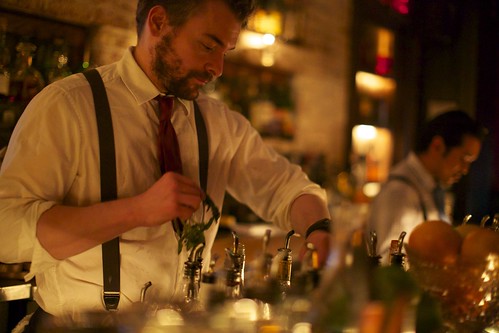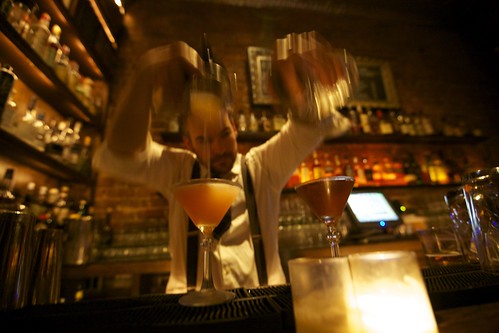
Since San Francisco mainstay Tosca Café closed its doors earlier this year, how many of us have peered longingly into the darkened North Beach Italian bar, its iconic, larger-than-life fluorescent sign dim and dark? Lucky for all of us, Tosca—which first opened in 1919—is seeing a second life and will soon reopen its doors. After a near closure, April Bloomfield and Ken Friedman—the team behind the Spotted Pig in New York—took over the bar’s lease. But how much will this new Tosca be like the old one and what can we expect? Isaac Shumway, Tosca’s new bar manager, gave us a sneak peek.
You might have seen my article earlier this week with Eater. Here's more of what Isaac and I talked about. No more looking into dark windows! Here are some excerpts.
Joy: So what is the new Tosca going to be like?
Isaac: The whole goal of the place is to keep it simple but done right—with an emphasis on doing everything, well, perfectly. We’re going to take things old school. Like, when’s the last time you saw an after dinner drink that’s old school?
I think there was a backlash on sickly sweet after dinner drinks during last nine years. There was a dark period in cocktail history during the 70's and 80's when products like Kahlua, Baileys, and things like Crème de Noyaux were popular in after dinner drinks. They’re not great products. They’re very manipulated and very sickly sweet. Now we have brands like Tempus Fugit going back and looking at these old recipes. Their Creme de Cacao is amazing. Or St George does a Firelit Coffee liquor using local coffee in it. You can come to Tosca and expect us to go back in time and do it right. It’s kind of like what you see now with 3D movies. Now we have the means to do it right.
Joy: Wait, so when you’re talking old school, are you talking like Prohibition or Pre-Prohibition? There are a lot of those bars. I think you used to work for one.
Isaac: Yeah, so for instance, I'm attempting the famous Cafe Brulot from the 1890's a lost and forgotten iconic drink of it's time and the Keoke Coffee, a drink that probably our grandparents were drinking. But I’m interpreting these drinks in a current and playful way. I think it's about taping into our memories or ideas of generations before us.
Joy: So those are like 70s drinks. But you’re thinking of redoing those drinks with other techniques from like Prohibition and today.
Isaac: Tosca was started in 1919, so there’s a lot of history—we’re going to be wearing the classic white jackets that we have always had. This makes me think back to the showmanship days of (19th century pioneering bartender) Jerry Thomas and the famous Blue Blazer. So for Tosca, we are trying to reinterpret and be playful. For instance, I'm really excited about attempting the Cafe Brulot. I’m thinking of a spice- and citrus-peel-infused brandy, using chicory-infused Sightglass coffee. And I’m hoping to involve a show of fire. Sightglass is a great local coffee company, and they’re helping us make us our own coffee blend—because when I think of Tosca, coffee definitely comes to my mind.

Joy: Do you feel pressured at all? Tosca is a historic place.
Isaac: I mean, yeah, I obviously want to make everyone happy. But we’re changing it. It’s going to be a different beast. It was always a simple dive bar and now I want to make it a simple neighborhood bar where you could come nerd out on cocktails—though that’s not what’s going to be the focus.
Joy: So you have a background in food. You went to the CIA and cooked at French Laundry and places like that. We’re all wondering, how does that play into your cocktails?
Isaac: We’re definitely going to try to incorporate ideas behind the philosophy of Italian dining. We are going to have a lot of Amaro. I am trying to get my hands on a lot of Fernets out there. Maybe offer different flights. The details are still being worked out.
Working in kitchens, the one thing I really took away was whoever has the best products will have the best restaurant. If you have two equal chefs and one is using the best ingredients and the other is not, it makes the world of difference. I learned it's about creating those relationships with people doing what they love to do and doing it right. For instance, we contacted a local Chocolate company called Dandelion for our famous house Cappuccino. This chocolate is amazing. We went out and formed a relationship with a small brewery called Mill Valley Beer Works—soon to be called Fort Point—here in the city. They will be brewing a house Tosca beer for us.
I'm also a huge believer in consistency. My whole team and I will be getting together to workshop classic cocktails. We will all be on the same page when it comes to classics.
Joy: That’s cool you’re workshopping classics. It feels like a lot of people in San Francisco are more into workshopping new drinks and seasonal ingredients.
Isaac: I don’t want to get stereotyped into one thing. I have a huge back bar, and we are going to do everything. I think San Francisco is a place where when I say a “neighborhood bar,” to the people who live here it’s a place you always want to come to and get a good drink—strong, basic classics. I want it to be the best Old Fashioned. The best Negroni. The best Manhattans. The best Daiquiris. Classic drinks. I’m old school.
Joy: How is that different from other people doing classics?
Isaac: I just feel like people are more focused on barrel-aged cocktails and shrubs and tobacco tinctures, and I feel like people forget how good a gimlet can be. I’m not saying I want to put a gimlet on the menu necessarily. But we will make great classics by using the best products—the best gin, the best fresh mint, organic citrus, the best ice available using the best glassware—and really taking the time to make sure we’re accurate when we measure and that we don’t skip steps that would make it perfect. We are talking bar spoon accuracy. Doing it right and doing it quickly.
And that’s again where I bring in that French cooking philosophy. That’s where I bring in the best ingredients and but don’t touch them too much. It’s about that simplicity, those three or four ingredients. And I think there is going to be a trend going back to it. Right now we’re in the middle of crazy conceptual cocktails and ideas. I think at the end of the day people want to come back from that.
Joy: In a way, that’s very San Francisco. Like a hearkening back to some history and at the same time going with the small batch, going with the local.
Isaac: It’s the revolt against Walmart. Handcrafted things of quality have died because you can’t compete with cheap pricing. And we have to support paying a little bit more sometimes to get something amazing. We have to support that small distillation on a farm that’s not producing very much, but it’s going to cost more. Or at least we find a balance between the two. And that’s huge. That’s also why San Francisco is so exciting. It’s like people are reaching out and embracing those smaller businesses. So when we say we’re a neighborhood bar, we’re also a reflection of the community.
- Noelle
Anticipated to re-open October 2013
242 Columbus Ave
San Francisco, CA 94133
(415) 986-9651
toscacafesf.com
toscacafesf.com
1 comment:
As you asked about Pre and Pro hibition....I wonder how prohibition was like....hard times :P Nice interview btw.
Post a Comment